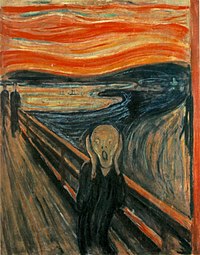
Photo from wikipedia
Background Incidences of social anxiety disorder (SAD), appearance anxiety, and eating disorders (ED) show an increased prevalence among young people. However, symptoms' associations between these disorders have not been investigated… Click to show full abstract
Background Incidences of social anxiety disorder (SAD), appearance anxiety, and eating disorders (ED) show an increased prevalence among young people. However, symptoms' associations between these disorders have not been investigated in depth. Network analysis is an approach that can be used to explain the relationship(s) between symptoms of different psychological disorders. Using network analysis, this study aimed to explore the association and potential interacting mechanisms between SAD, appearance anxiety, and ED. Methods This study included 96,218 University students from Jilin Province, China. SAD, appearance anxiety and ED were assessed using the Social Anxiety Subscale of the Self-Consciousness Scale (SASS), the Appearance Anxiety Scale Brief Version (AASBV), and the Sick, Control, One, Fat, Food questionnaire (SCOFF), Chinese versions. Network analysis was employed to investigate the symptom associations, while the stability of the network model was analyzed using statistical measures. Results The prevalence of ED among the total sample was 38% (95% CI: 38.1–38.8%), while this figure was 31.2% (95% CI: 30.7–31.6%) in males and 43.6% (95% CI: 43.2–44.0%) in females. Additionally, the total score of SAD was significantly higher in females (11.83 ± 5.37) than it in males (10.02 ± 5.46) (P < 0.001). While the total score of appearance anxiety was also different significantly in gender (39.21 ± 9.49 in females vs. 38 ± 9.42 in males) (P < 0.001). Results showed that ED was associated with all three aspects of appearance anxiety, including “appearance concern,” “appearance satisfaction,” and “wish for good looks.” Appearance anxiety and SAD were also associated; specifically, symptoms of “appearance satisfaction” were significantly associated with the symptoms “easily talk to strangers” and “appearance concern”, which was also significantly associated with “embarrassed”. Compared with males, females showed significantly stronger associations with appearance anxiety symptoms, while ED symptoms were associated with “troubled by being watched” and “appearance concern”. Conclusion Appearance anxiety was associated with both ED and SAD symptoms. ED may have a potential relationship with SAD, affecting appearance anxiety indirectly. Significant differences were found among males and females in symptom associations between appearance anxiety and SAD. This study therefore clarified that young people should have body-positive interventions and challenge the normative body image discourse, which may help alleviate symptoms of SAD and ED.
Journal Title: Frontiers in Public Health
Year Published: 2022
Link to full text (if available)
Share on Social Media: Sign Up to like & get
recommendations!